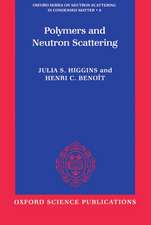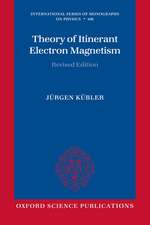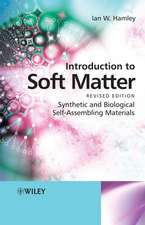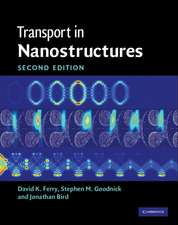Crystal Defects and Crystalline Interfaces
Autor Walter Bollmannen Limba Engleză Paperback – 16 noi 2012
Preț: 828.95 lei
Preț vechi: 1010.92 lei
-18% Nou
Puncte Express: 1243
Preț estimativ în valută:
158.62€ • 165.95$ • 131.77£
158.62€ • 165.95$ • 131.77£
Carte tipărită la comandă
Livrare economică 03-17 aprilie
Preluare comenzi: 021 569.72.76
Specificații
ISBN-13: 9783642491757
ISBN-10: 3642491758
Pagini: 268
Ilustrații: XI, 254 p.
Dimensiuni: 155 x 235 x 14 mm
Greutate: 0.38 kg
Ediția:Softcover reprint of the original 1st ed. 1970
Editura: Springer Berlin, Heidelberg
Colecția Springer
Locul publicării:Berlin, Heidelberg, Germany
ISBN-10: 3642491758
Pagini: 268
Ilustrații: XI, 254 p.
Dimensiuni: 155 x 235 x 14 mm
Greutate: 0.38 kg
Ediția:Softcover reprint of the original 1st ed. 1970
Editura: Springer Berlin, Heidelberg
Colecția Springer
Locul publicării:Berlin, Heidelberg, Germany
Public țintă
ResearchCuprins
1. Introduction.- 1.1. The Significance of Crystal Defects.- 1.2. The Nature of Crystal Defects.- 2. General Aspects of the Structure of Crystals.- 2.1. Outline.- 2.2. Mathematical Description of the Crystal.- 2.3. Classification of Crystal Structures.- 3. Some Special Crystal Structures.- 3.1. Outline.- 3.2. Close-Packed Structures.- 3.3. The Face-Centred Cubic Structure.- 3.4. The NaCl-Structure.- 3.5. The Diamond Structure.- 3.6. The Body-Centred Cubic Structure.- 3.7. The Close-Packed Hexagonal Structure.- 3.8. The Graphite Structure.- 3.9. Irregularities in the Stacking Sequence.- 3.10. Energy of Stacking Faults.- 3.11. Fibrous Structures.- Chapters 2–3. Summary and Discussion.- 4. Point Defects.- 4.1. General Considerations of the Field of Point Defects.- 5. The Individual Dislocation: Geometrical Basis.- 5.1. Outline.- 5.2. Definition of the Dislocation Line and the Burgers Vector.- 5.3. Relative Orientation of b and l.- 5.4. Motion of Dislocations.- 5.5. Dislocations and Moiré-Figures.- 6. Interaction Between a Dislocation and its Surroundings.- 6.1. Outline.- 6.2. Representation of the Stress Field.- 6.3. Forces Acting on a Dislocation.- 6.4. Energy of a Dislocation.- 6.5. The Line Tension.- 6.6. The Strain Field of a Dislocation.- 6.7. The Stress Field of a Dislocation.- Chapters 5–6. Summary and Discussion.- 7. The Interaction of Dislocations.- 7.1. Outline.- 7.2. Interaction Between two Parallel Screw Dislocations.- 7.3. Interaction Between two Parallel Edge Dislocations.- 7.4. Dislocation Reactions.- 7.5. Dislocation Reactions in Special Crystal Structures.- 8. Partial Dislocations.- 8.1. Outline.- 8.2. Partial Dislocations in the Face-Centred Cubic Structure.- 8.3. The Sequence of Partial Dislocations.- 8.4. Transformation of the Face-Centred Cubic— into the Close-Packed Hexagonal Structure.- 9. Dualistic Representation of Dislocation Reactions.- 9.1. Introduction.- 9.2. The Significance of the b-Net.- 9.3. The Prediction of Dislocation Reactions.- 9.4. Dislocation Reactions Involving Partial Dislocations.- 9.5. Thompson’s Notation of the Burgers Vectors.- Chapters 7–9. Summary and Discussion.- 10. Short Description of the Relations Between Dislocations and Point Defects, and Dislocation Dynamics.- 10.1. Dislocations and Point Defects.- 10.2. Dislocation Dynamics.- 11. Dislocation Networks — Subgrain Boundaries.- 11.1. Introduction.- 11.2. Frank’s Formula.- 11.3. Classification of Subgrain Boundaries.- 11.4. “Special” Subgrain Boundaries.- 11.5. Foreign Dislocations.- 11.6. “General” Subgrain Boundaries.- 11.7. The Energy of a Subgrain Boundary.- 11.8. Some Considerations of Recrystallization.- 11 9 Limiting Cases.- 11.10. Dualistic Representation in Three Dimensions.- 11. Summary and Discussion.- 12. General Geometrical Theory of Crystalline Interfaces.- 12.1. Introduction.- 12.2. The Coincidence-Site Lattice.- 12.3. The O-Lattice.- 12.4. The O-Lattice and Frank’s Formula.- 12.5. The b-Lattice.- 12.6. Various Aspects of the 0-Points.- 12.7. The Actual Formulation of the Transformation A.- 12.8. Choice Between Various Possible Transformations A.- 12.9. Solutions of the Basic Equation.- 12.10. The Behaviour of the O-Lattice upon Translation of Lattice 2.- 12.11. Translation of the O-Lattice for the Case of Rank (T) < 3.- 12.12. Subdivision of the Crystal Space into Cells.- 12. Summary and Discussion.- 13. Applications of the O-Lattice Theory.- 13.1. Outline.- 13.2. Example of an Optimum Phase Boundary.- 13.3. The Periodicity of the Pattern of Lattice Points.- 13.4. Displacement of thePattern.- 13.5. Dislocation Networks in General Crystalline Interfaces.- 14. Completion of the Linear O-Lattice Theory and Extension to Non-Linear Problems.- 14.1. Outline.- 14.2. Dislocations and Burgers Vectors in Crystalline Interfaces.- 14.3. Non-Linear Problems.- Chapters 13–14. Summary and Discussion.- A 1 Matrix Calculation Procedures.- A 2 Moiré-Models.- A 3 The Direct Observation of Crystal Defects.- References.- Sources of the Illustrations.



















